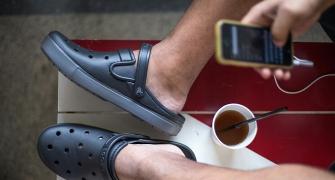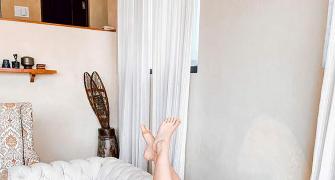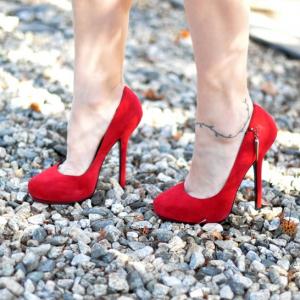The ideal height of the heel should be between three to nine centimetres.
Any higher than that combined with the lack of comfort comes at an additional cost of pressure on your lower back, knees, and ankles, cautions Dr Manan Vora, orthopaedic surgeon and sports medicine expert.

Let's admit it. High heels make you look tall, sleek and stylish in an instant.
In fact, women in corporate roles, luxury, hospitality and entertainment businesses wear it almost every day to work.
The reason you need to make sure your heels suit your feet go beyond the health issues.
With habitual wearing of heels that are higher than two inches, the Achilles tendon and calf muscles can face changes in shape.
As the shoe heel pushes up the human heel, the Achilles tendon and calf muscles are facing increased pressure. This may also cause the tendon to shorten, the muscles to stiffen and then reshape.
It can create pain in the body's lower extremities.
Hence it is important to take necessary care when it comes to footwear.
Here are a few tips you can keep in mind when searching for your next pair of footwear:
1. Pick the right size
While purchasing the heels, ensure that you buy the correct size, with a perfect fit that is comfortable and reduces the risk of injury.
If it is one size bigger, there are chances you may fall.
However, if you buy a smaller size, the tight footwear can cause pain.
2. Pick the right shape
Women have different kinds of feet -- narrow, wide, small or long toed.
For wider feet, close tapered footwear would be a bad idea and wide front (closed or open toed) footwear would be a better option. Similarly, pointed shoes would pinch your toes.
When you start walking, heels that cramp your toes will cause pain and increase the possibility of getting bunions, corns and developing hammertoes and even arthritis later in life.
3. Check padding
Another crucial buying tip for buying any footwear would be to check the padding on the balls of the feet.
Check if it has proper padding and cushioning in the area that supports the balls of feet.
High heels with excellent cushioning and padding provide great support and comfort to your feet.
4. Check the placement of heels
When you try them out the first time, check the placement of the heel.
The heel should ideally be placed under your own heel.
This leads to minimum damage and greater support while walking.
5. Go for platform heels
Remember, thicker the heel, the greater the support it provides for your body.
Ideally look for platform heels that will distribute your weight across the entire foot evenly instead of concentrating it at the ball of the foot or the heel.
They also decrease the risk of sprained ankles.
6. Check the height
The ideal height of the heel should be between three to nine centimeters.
Any higher than that combined with the lack of comfort comes at an additional cost of pressure on your lower back, knees, and ankles.
Heels higher than this do not give any support for balancing.
7. Sit down, take breaks
If your job requires you to wear them all day, remember to take frequent breaks whenever you can. Sit down as much as possible.
Wear them only on special occasions in order to avoid buildup of discomfort or pain.
Wearing high heels occassionally may not pose any immediate dangers to your health.
However, wearing them daily or more than thrice a week week may hamper your ankles, knee, hip and lower back.
Long-term use can even cause structural changes in the foot itself, leading to bunions, hammertoe, neuroma, equinus, and other conditions that may require surgical correction.
In addition to injury, high heels place excessive stress on the back and lower extremities that can profoundly affect posture, gait, and balance.
A little extra care and mindfulness can take us a long way, quite literally.
Dr Manan Vora has completed medical school and surgical residency in orthopaedics from Mumbai. He holds a diploma in sports medicine from the International Olympic Committee, Switzerland and Masters in Surgery (MCh Orth) from the University of Edinburgh, and Royal College of Surgeons, Edinburgh, UK.
Disclaimer: All content and media herein is written and published online for informational purposes only. It is not a substitute for professional medical advice. It should not be relied on as your only source for advice.
Please always seek the guidance of your doctor or a qualified health professional with any questions you may have regarding your health or a medical condition. Do not ever disregard the advice of a medical professional, or delay in seeking it because of something you have read herein.
If you believe you may have a medical or mental health emergency, please call your doctor, go to the nearest hospital, or call emergency services or emergency helplines immediately. If you choose to rely on any information provided herein, you do so solely at your own risk.
Opinions expressed herein cannot necessarily provide advice to fit the exact specifics of the issues of the person requesting advice.










